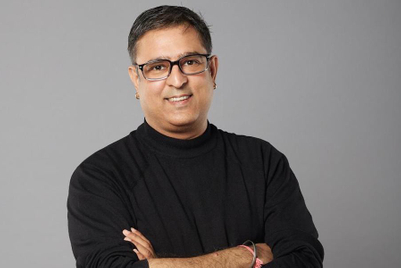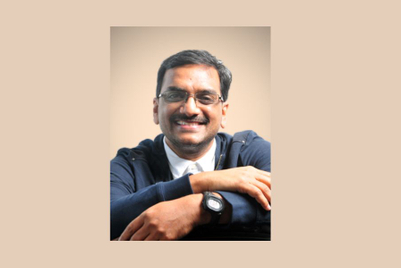
Rahul Sengupta started out in media planning at JWT, quickly shifted to creative at Mudra, and spent 11 years at Lowe Lintas. Now national creative director of TBWA, he talks about his stints, his learnings, his ambition for TBWA, and why that may still not be enough to get kids to join advertising.
You went to St Xavier’s Kolkata, and then for an MBA to Faculty of Management Studies. How come the jump to copywriting?
I essentially got bored. I knew I wanted to get into advertising and it took me a while to figure out I wanted to do copywriting. I was always the smart ass in college, doing the college posters. It seemed like a pretty good way to meet women if you couldn’t play the guitar. It was just the clever streak that prompted me to get into advertising.
So MBA got me through the doors of an agency called JWT, in media planning, and in three months I moved into creative. Then I went for a servicing interview to Mudra in the middle of June ’93, wearing black shoes, a pink shirt and a tie. And I couldn’t see myself doing this afternoon after afternoon. So I went in for the interview and said, “Please let me get into creative.” And I joined creative. We were in a combined programme called MMTP in Mudra which was a two-month course: one month, account management people from Mudra came and made us go through Kotler all over again, and we waited for the creative directors to come. They came the next month (Balki, Raj Mohan Tella, Prathap Suthan) and it was fun. Then I moved to Mudra Bangalore for two years where I worked with Balki, and then came to Mudra Mumbai. Then Balki moved to Lowe Lintas, so I went to Lowe and stayed there for 11 years.
What was Bangalore advertising like versus Mumbai?
It was heaven. We always wanted to go to Bangalore. It was the coolest city when we were drawing Rs 2000 a month for sure. It was affordable, and there were many people buying you beers (a pub called Night Watchman located below the Lowe Lintas office used to be called ‘Lower Lintas’). I don’t think in those days people used to think that Bangalore is a poorer cousin of Mumbai. They took pride in doing great work out of Bangalore, and it was really a source of a lot of awards etc, which is not the same case today. But in those days, like wanting to beat Australia in cricket, it was always to beat Mumbai in advertising.
After Lowe, you also did something in television for a bit?
I left Lowe finally and I wanted to do something in television. I’d started a company with Mad Entertainment called Mad Box and we were writing content for channels. I threw my hands up because if advertising seems like a disorganised sector, you have to work in television. It’s an almost industry, because it’s almost there and then nothing happens and then you sit and wait.
Are the differences in cultures between the agencies (Mudra, Lowe Lintas and TBWA) apparent?
Mudra is like another year in college. There is nobody who is more senior or more junior in Mudra. It’s like a big college canteen that does work. It’s a great culture. Like college friends, all the people who work in Mudra will always stay your friends. Lintas is supremely a non-advertising agency. It just believes it’s the best and it ranks people within itself to see who’s better than the other; it doesn’t look at the industry. Smartly so, because the industry is a little lost, it’s constantly trying to outwin the other at awards, which is a pretty hollow game to play. But Lintas gives you the confidence to be yourself and form your own arrogance. TBWA is so different from the last two places I have worked in because they were all established. Mudra and Lowe were like Sachin and Dravid. TBWA is making a debut, it’s got lots to prove, hopefully building a reputation for itself, hopefully uncorrupted by a lot of the undesirables of chasing awards. It just wants to make an honest name for itself, do honest work for its clients and that’s why a lot of people here are from those schools of thought in the past. Nobody is keen to disrupt the good practices of advertising, they just want to set up a new shop with those practices.
What’s changed since 1993 to 2008, when you joined TBWA as national creative director?
In those days, if you wanted to do something offbeat, then advertising seemed like a good creative avenue. The difference today is that advertising has become on-beat, and a lot of other things seem offbeat. Now there are a lot of cool things you can do – join a television channel, make films, work in radio, create apps for Apple, the world is a much, much bigger oyster today and it’s just opened up. Youngsters today consider advertising to be one of ten options; it’s no longer the one thing to do to prove to your parents you’re a clever dude.
It is a problem getting talent. Earlier people used to come in and say, “Give me a job in advertising and I’ll owe you.” Today people come and say, “Convince me why I should join advertising.” More often than not, I can’t convince them. If they really want to do it, they come back to one agency or the other. But you can’t convince this generation of anything. They’ll come to you once they make up their mind.
Though you didn’t take up a career in servicing, have you ever come across a perfect brief?
I’ve had really good briefs, but most of them are not in a conference room. I’ve had some really good briefs in a pub, or while smoking. I think the informality of a brief over a conversation is the best brief. Somebody had briefed me in the Bangalore days that “Jewellery can be like a diet. If you follow a good diet, you feel good. If you wear good jewellery, you feel good.” I thought that was a fantastic brief, and an idea came out of that.
What’re your views on digital?
I can barely use my phone, and I know how to access Facebook, so that’s my expertise in digital. Today, the youth don’t spend much time on television, they spend time on the net. So just by the usership, digital is here to stay because consumption habits have changed. What agencies are doing to tackle digital is really abysmal because there is no expertise. Putting three people into a room and asking them to do digital isn’t digital. Digital needs a lot of quality people. Everyone puts a tick in a box and says, “We have a digital agency” but far from it. We have a tie up with Ignitee and we let them be the experts. When they make a presentation on digital, we let them lead. We don’t see them as resources but see them as specialists.
Where do you see Indian advertising, TBWA India and yourself going in the next two years?
I don’t think any agency knows where they’ll be two years from now on. The only thing they know right now is they want to be bigger. Even I don’t know where I will be. I worry about it, but I have no idea. As for TBWA, if a 23-year old person tomorrow looks at a piece of work and says, “I want to work in the place that did that”, and a lot of 23-year olds start doing that, that’s where I want this agency to be.
Indya.com, 2000: Initially conceived as a radio spot. Till Sunil Lulla saw a bigger scope for the idea. Indya.com was the kind of brand you join advertising for.
Bajaj Caliber, 2002: Hoodibaba. This was the audacity of Balki. To go into one of the biggest pitches of that time with a one word idea.
Bajaj Wind Biking, 2003: Film opens in Prague. Agency and producer spend time in a casino. Bajaj loves the film. Life is beautiful.
Titan Fastrack, 2005: The best part of making this film were the screen tests. Every model who came in had to fake the big O. Everybody wanted to work on the account after that.
Tanishq, 2006: The media plan had 30s only. CKV, the Tanishq head, took one look at the edits and changed the media plan to 60s. I was always proud to work on that business.
Fastrack, 2007: A Tamil track for an Indian youth brand. A day in music studios and recording sessions can create more impact than days of writing a strategic presentation.
Maruti, 2009: Maruti is way ahead of other car players in the kind of scripts they buy. They follow no rulebooks. Just good old Delhi common sense.
Set Max IPL, 2009: The client bombed this film. Samiruddin weaved magic with the track. The client loved the film. Moral of the story: Never present a rough cut in your life.
V Guard, 2010: A brainchild of TBWA Bangalore. I think we spent 3 days editing this. I still don’t understand this film and its logic. But I love it.


.jpg&h=268&w=401&q=100&v=20250320&c=1)
.jpg&h=268&w=401&q=100&v=20250320&c=1)


.png&h=268&w=401&q=100&v=20250320&c=1)



